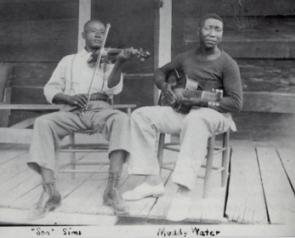 |
| Ota yhteyttä: admin (a) blues-finland.com © 2007 Blues-Finland.com |
| Muddy Waters Part 1: Mississippi The man known as Muddy Waters was born McKinley A. Morganfield on April 4, 1913 in Jug's Corner, Issaquena County, Mississippi. Settling in Chicago in the 1940s, he would change the year to 1915 in an effort to look younger for showbiz, and the place to Rolling Fork, Sharkey County -- simply because Rolling Fork was where the train stopped, the nearest place "on the map". Although his now-famous nickname does date back to his childhood, the 's' at the end of Waters was only added in 1948, on the label of his first hit record "I Can't Be Satisfied"/"I Feel Like Going Home". |
 |
| Muddy's mother was Berta Grant, reportedly at least 12 and less than 20 years old when her son was born. Muddy's father, Ollie Morganfield, born October 20, 1890, was known in the area as an entertainer, singing and playing guitar and washboard at country parties. However, when Muddy took his band to meet his Dad in the 1950's, James Cotton asked the old man if he played the guitar and Ollie just pointed to Muddy, stating proudly: "No, that boy!" Muddy's parents never married, and it was his maternal grandmother, Della Grant, who raised him; she was 32 when Muddy was born. By the spring of 1920, they had moved 80 miles north to the Stovall Plantation in Coahoma County. It was there that Muddy was to make his first recordings for the Library of Congress, identifying himself in 1941 as "Stovall's famous guitar picker". That's How You Learn Muddy's first instrument was a kerosene can he used for a drum, next came the accordion, then the Jew's harp, and then a guitar he built from a box and a stick: "Couldn't do much with it, but that's how you learn!" By the time he was 13, he had spent 6 years mastering the harmonica; although he rarely played it in his later years, his skills were still formidable enough to impress a young James Cotton when the young harpist was taking over Little Walter spot in Muddy's band in the 1950's. There was no electricity at Stovall, but Della purchased a hand-powered phonograph, and although she was mostly into church music, Muddy was soon listening to recordings by Texas Alexander, Barbecue Bob, Blind Lemon Jefferson, Blind Blake, Son House, Charlie Patton, Roosevelt Sykes, and Little Brother Montgomery. When Muddy was 14, he saw Son House perform; awed by House's bottleneck technique, he kept going back to see him: "I was there every night, close to him. You couldn't get me out of that corner, listening to him. I watched that man's fingers and look like to me he was so good he was unlimited." Three years later, Muddy sold the last horse they had for 15 dollars, gave his grandmother 7.50, and spent 2.50 out of the remainder on his first proper guitar -- a second-hand Stella: "The first time I played on it I made fifty cents at one of those all-night places, and then the man that run it raised me to two-fifty a night, and I knew I was doing right." As soon as he'd saved 14 dollars from gig money, he ordered a brand-new guitar from the Sears Roebuck catalogue. Incidentally, the first piece Muddy learned on guitar was Leroy Carr's "How Long Blues". I Got Hip McKinley Morganfield made his living 50 cents a day working 15-16 hours a day in the cottonfield, earning extra from music, trapping furs, and selling and making bootleg whiskey: "I'd have my own Saturday-night dances. I got hip and started making and selling my own whiskey, playing for myself." When cotton was not in season, he was hopping rails and running around with musicians like Robert Nighthawk, Tommy Johnson, Robert Lockwood Jr., Sonny Boy Williamson II, and Big Joe Williams. For a while, Muddy played harmonica with Big Joe, and although accounts differ as to how long and far they travelled together, both kept insisting that the reason they went their separate ways was that Muddy was getting all the women. On November 20, 1932 Muddy married Mabel Berry; Robert Nighthawk played guitar at the wedding, and the party reportedly got so wild the floor fell in. Mabel left Muddy three years later when Muddy's first child was born - the child's mother was Leola Spain, sixteen years old, "married to a man named Steve" and "going with a guy named Tucker". Leola was the only one of his girlfriends with whom Muddy would stay in touch throughout his life; they never married. By the time he cut out for Chicago in 1943, there was another Mrs. Morganfield left behind, a girl called Sallie Ann. Going to Chicago was not an easy decision, however. By Muddy's own admission, he rambled like a "rollin' stone", but never too far -- he did not want to leave his grandmother. When Robert Nighthawk invited him to go to Chicago with him, Muddy thought it was a joke: "Going to Chicago was like going out of the world. Finally he split, and the next time I heard, he had a record out." I Be's Troubled Some of Muddy's bootlegger-buddies like Skip James were also becoming recording artists, as were fellow Son House fans such as Robert Johnson, a "dangerous man" whom Muddy remembered as playing in the street in Friar's Point. Johnson was soon dead, but his records were beginning to generate interest among Northern whites. Thus it happened that on August 31st, 1941, the white folklore collector Alan Lomax from the Library of Congress and his black associate, professor John Work of the Fisk University arrived on the Stovall Plantation, looking for "blues singers in the style of Robert Johnson". When Muddy heard there was a white man looking for him, he figured it must be the revenue man after him for his moonshine business -- just as years later he would run from Paul Butterfield, Nick Gravenites, and Elvin Bishop, taking the dressed-up white blues fans for agents of the IRS. Muddy's fears where soothed as Lomax set up his equipment, and he performed three songs: "I Be's Troubled", "Country Blues", and "Burr Clover Farm Blues". On the last track, Muddy was accompanied on second guitar by Henry "Son" Sims. Born in 1890, Sims played the violin, piano, bass, viola, mandolin, and guitar, and had recorded in Wisconsin with Charlie Patton. A fan of the Mississippi Sheiks, Muddy had hooked up with the similar-sounding Son Sims Four in 1933; Lomax would be back to record the full band in 1942. But it was the two 1941 solo numbers that would build up Muddy's confidence for the move to Chicago and -- as electric reworkings on Chess -- provide his first hit. In January 1943, Lomax sent Muddy two copies of the Library of Congress that had one of his tunes on either side; Muddy got dressed up and had his picture taken with the disc, something he had never done with either of his wives. Six months later Muddy the tractor driver got into an argument over his wages with the plantation overseer, and armed with his grandmother's blessings, a borrowed suit of clothes and an acoustic Sears Silvertone guitar, boarded the train for Chicago. ANDRES ROOTS - - - - - The three-part Muddy Waters biography continues with the episodes "Chicago" and "Champagne & Reefer". In a poll arranged in the autumn of 2007, the readers of Blues-Finland.com voted Muddy the favourite blues artist of all time. |
| "Muddy Water" and Son Sims, 1943. |
